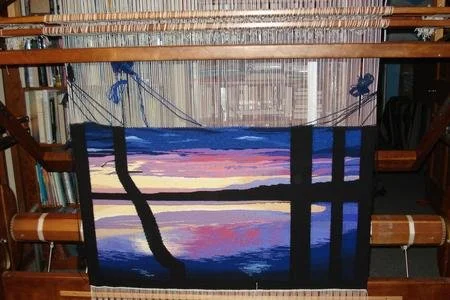My work usually begins with an experience which strikes a chord. I use a digital camera and sketch book to capture and develop my ideas. The decision as to whether the image will be a tapestry or a painting is made during this part of the process. I look at all aspects of the image to make that decision; which medium would best capture the color, the movement and the detail of the image. Likewise, if there is a lot of detail that would be lost in a textile, I will choose to paint.
Tapestry weaving is a very basic form of weaving. The warp threads are tied to the loom in a way that allows the weaver to raise alternate threads with each pass of the weft. The weft is packed down to hide the warp threads and carries the color which creates the image. The image is built from bottom to top row by row.
The lure of the loom is strongest when I want to combine a physical experience with the development of the image. Most of my work is about water so the ideas of pattern and rhythm are part of the process. The structure of weaving is great for transcribing the repetitive nature of water and tides. The imagery changes to fit the weaving process. I like to build shapes one upon another, that mimic the way water works the mud on my beach and light on the waves. Lately, I have been working without a cartoon but if I am using one, it is usually just the outline of the major components. I refer to my drawings and photos for color ideas but invariably choose those when I go to my storage shelves for yarn. I weave on a Crisp “Ruthie” vertical tapestry loom; it is a two harness loom with a maximum width of 5 feet. I usually warp at 8 ends per inch and use seine twine as a warp. My weft is Hifa vevgarn at two strands which allows me to blend as needed. I prefer to use a Persian braid when finishing my pieces and either mount them on stretched canvas or use Velcro to attach them to a mounting fixed to a wall.
Unlike tapestry, the painted image changes in organic unpredictable ways. With tapestry, most of the design decisions are done in advance and the piece grows from bottom to top. In painting, it’s not finished until the painter declares it over.

